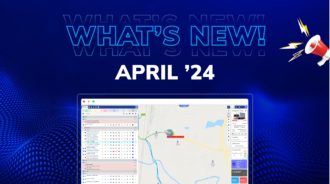In the demanding world of heavy-duty industries, the efficiency of Off-the-Road (OTR) tires is pivotal. The emergence of advanced tire management software has revolutionized how these tires are monitored and maintained. Our cutting-edge software offers comprehensive solutions, including tire inventory management, thorough tire inspections, operational tracking, and insightful reports and alerts. In this blog, we’ll explore the latest trends in tire management and how our software stands as a crucial tool in this evolution.
Understanding OTR Tires and Their Significance
OTR tires, the backbone of heavy machinery in sectors like mining and construction, demand meticulous management due to their impact on safety and operational efficiency. Our software addresses these needs by offering a holistic approach to tire management, ensuring each tire’s optimal performance throughout its lifecycle.
Off-the-Road (OTR) tires are a pivotal component in various industries, including mining, construction, and large-scale agriculture. Understanding their design, purpose, and the challenges associated with their use is crucial for appreciating the value of advanced tire management systems.
The Design and Build of OTR Tires
OTR tires are uniquely designed to meet the demands of heavy-duty applications. Here are some key features:
- Robust Construction: These tires are built to withstand heavy loads, extreme terrains, and harsh environmental conditions. They are often larger and sturdier than standard vehicle tires.
- Specialized Tread Patterns: Depending on their application, OTR tires have specific tread patterns. For instance, tires used in mining may have deeper treads for better grip on loose surfaces, while those used on construction sites might have wider treads for stability.
- Reinforced Sidewalls: To handle heavy loads and prevent punctures or damages, OTR tires have reinforced sidewalls. This feature is crucial for maintaining tire integrity in rough conditions.
The Purpose of OTR Tires
OTR tires are not just about mobility; they play a significant role in the overall efficiency and safety of heavy machinery. They are designed to:
- Ensure Safety: In industries where machinery operates in challenging environments, tire failure can lead to severe accidents. Therefore, the reliability of OTR tires is vital for the safety of the operators and the machinery.
- Enhance Performance: Good quality OTR tires can significantly improve the performance of heavy-duty machinery. They ensure better traction, stability, and handling, which is essential for efficiency and effectiveness in operations.
Challenges in Managing OTR Tires
Managing OTR tires comes with its set of challenges:
- Wear and Tear: Due to their heavy usage, OTR tires are prone to significant wear and tear. Regular inspection and maintenance are necessary to extend their lifespan.
- Cost Implications: OTR tires represent a significant investment. Their maintenance and replacement entail considerable costs, making efficient management crucial for cost savings.
- Environmental Factors: Exposure to harsh environments like extreme temperatures, abrasive surfaces, and corrosive materials can affect the longevity and performance of these tires.
The Significance of Effective Tire Management
Given these factors, effective tire management becomes crucial:
- Preventing Downtime: Regular monitoring and maintenance of OTR tires can prevent unexpected failures, reducing downtime in operations.
- Extending Tire Life: Proactive management, including regular inspections and maintenance, can significantly extend the life of these expensive assets.
- Optimizing Performance: Well-maintained OTR tires contribute to the overall efficiency and productivity of the machinery they are fitted on.
Embracing the Latest Trends in Tire Management
Recent trends in tire management emphasize efficiency, safety, and data-driven decision-making. Our software aligns with these trends, offering features that streamline tire management processes and enhance operational effectiveness.
Simplified Inventory Management
Managing a large inventory of OTR tires can be complex. Our software simplifies this process by providing a user-friendly platform for tracking tire inventory, ensuring you always have the right tires in stock and reducing unnecessary expenditure on surplus inventory.
Comprehensive Tire Inspections
Routine inspections are essential for tire longevity and safety. Our software’s tire inspection feature allows for detailed checks, recording the condition of each tire and alerting you to potential issues before they escalate into major problems.
Operational Tracking
Monitoring tire usage and performance in real-time is a game-changer. Our software’s operational tracking feature provides valuable insights into each tire’s performance, helping you make informed decisions about maintenance and replacement.
Data-Driven Reports and Alerts
The power of data in tire management cannot be overstated. Our software generates detailed reports and alerts, offering a clear view of your tire inventory’s status, performance metrics, and maintenance needs. This data-driven approach facilitates proactive management and decision-making.
The Advantages of Our Advanced Tire Management Software
Our software isn’t just a tool; it’s a comprehensive solution that transforms how OTR tires are managed.
Enhanced Safety
Safety is paramount, and our software plays a crucial role in ensuring it. By providing timely alerts and accurate data on tire conditions, it also significantly reduces the risk of tire-related accidents.
Operational Efficiency
Efficiency is key to profitability. Our software optimizes tire usage, ensuring each tire is used to its full potential and reducing downtime due to tire failures.
Cost-Effectiveness
Our software is an investment that pays dividends. By extending tire life and optimizing inventory, it also offers substantial cost savings over time.
Best Practices for Maximizing the Benefits of Our Software
To fully leverage the capabilities of our advanced tire management software for OTR tires, it’s essential to integrate it effectively into your operational processes. Here are some best practices that can help maximize the benefits of this sophisticated tool.
1. Regular and Consistent Use
- Daily Monitoring: Make it a routine to check the software daily for updates on tire conditions, inventory levels, and performance metrics. This regular engagement also ensures you are always on top of any changes or issues.
- Incorporate into Routine Checks: Integrate the software’s use into your regular maintenance schedules. Use the data provided to guide these checks and also ensure they are more targeted and efficient.
2. Data-Driven Decision Making
- Utilize Analytics: The software offers detailed analytics and reports for OTR tires. Regularly review these to understand trends, identify potential issues, and make informed decisions about tire maintenance and replacement.
- Respond Proactively to Alerts: Set up and heed alerts for issues like low tread depth or high tire pressure. Responding quickly to these alerts can prevent further damage and reduce the risk of accidents.
3. Effective Inventory Management
- Track Inventory Accurately: Use the software to maintain an accurate record of your tire inventory. This helps in planning purchases and ensures you have the right tires available when needed, avoiding operational delays.
- Analyze Tire Utilization: The software can provide insights into which tires are being used most and how they are performing. Use this information to optimize your tire rotation strategy and extend the overall life of your tire inventory.
4. Comprehensive Record-Keeping
- Maintain Detailed Records: Utilize the software’s capability to keep detailed records of each tire’s history, including usage, maintenance, inspections, and performance. This comprehensive history is invaluable for predicting future tire needs and performance.
- Document Inspections and Maintenance: Ensure that all inspections and maintenance activities are recorded in the software. This creates a valuable database for tracking the health and lifespan of each tire.
6. Integrating with Other Systems
- Leverage Integrations: Take advantage of any integrations that can enhance the functionality of the software, such as connecting it with vehicle tracking systems or maintenance scheduling tools.
7. Continuous Evaluation and Adaptation
- Regularly Evaluate Software Use: Periodically evaluate how the software is being used and the benefits it’s providing. Moreover, this assessment can help you identify areas for improvement.
- Stay Updated with Software Upgrades: Keep the software updated with the latest features and improvements. Staying current ensures you are always using the most advanced tools available.
Conclusion
The trends in advanced tire management are clear: efficiency, safety, and data-driven approaches are key. Our software embodies these trends, offering a comprehensive solution that transforms the way OTR tires are managed. Embrace this change and leverage our software to enhance your operational efficiency, safety, and also cost-effectiveness. Remember, in the world of heavy-duty machinery, the right tire management can make all the difference.



